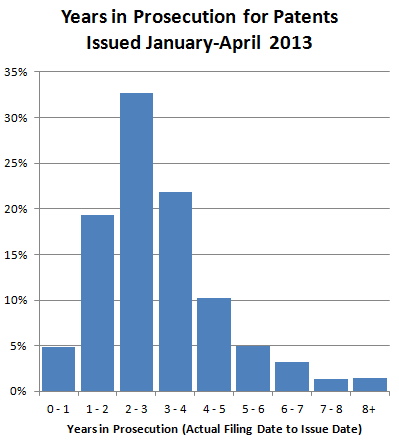By Dennis Crouch

You can get this from the chart, but the median pendency is under three years when considering all issued utility patents. The long tail increases the average pendency to a bit over three years.
Many of the fastest patent issuances are coming from the Patent Prosecution Highway (PPH). See, for example, U.S. Patent No. 8,406,758. In that case, the EPO issued its search report indicating that all of the claims included an inventive step. US patent attorney Stephen Chen then filed the US national stage application along with a request to participate in the PCT-PPH program. Four months later, the considered the application and issued a notice of allowance.
Minor foot pain can be very uncomfortable, but usually passes very quickly once the feet are rested.
You don’t need different languages to get different search results.
See slides 13 and 14 of Trilateral Collaborative Metrics Study.
These show average numbers of documents cited in the national first action in comparison with the ISR. The USPTO does not even agree with itself, citing lots of additional documents even where they did the ISR.
One conclusion that could be drawn is that a WOISA from the USPTO is of considerably lower value than one from EPO or JPO, as the USPTO disagrees with itself more than the other trilateral ISAs.
Another question that arises is whether the EPO is right to appear so smug in re-using their ISRs at the national phases.
So how does this affect PPH? The bottom right cell of the table on slide 14 shows that where the ISA is not the same as the national office and the WOISA indicates patentable subject matter, there is first action agreement only 37% of the time. [When the USPTO is ISA it agrees with itself only 42% of the time].
Taken at face value, this is a surprisingly low level of agreement and raises the question of whether PPH is good for PR but not particularly good for dealing with backlogs. See here for a strained analogy.
[By the way, I use PPH myself – it is a useful tool for the applicant].
magic, yo!
I can tell you that since the USPTO only has searchable translated abstracts of JPO patents and publications, it’s uncommon to cite a Japanese document in a rejection unless it was cited on an IDS. As for how often JPO cites Japanese art when we allowed it in the US, I honestly don’t know.
I wonder if the opposite is true — that the USPTO misses a lot of Japanese/Korean language art? Anyone have any thoughts on this?
New PPH cases go on the examiner’s Special Program New docket, which for most examiners is empty most of the time. The examiner has a 14 day average time to post an action in the case, which usually means they will take up the case within the next biweek after it’s docketed to them.
In my experience, though, most PPH cases go in the other direction, i.e., the USPTO allows the case first. I guess it has something to do with deferred examination in JPO and elsewhere.
On a side note, don’t expect PPH to mean your case will get allowed quickly in the USPTO, particularly if the first allowing office was JPO or KIPO. They focus their search on the Japanese and/or Korean patent databases and therefore miss a lot of English-language art.
Comments are closed.